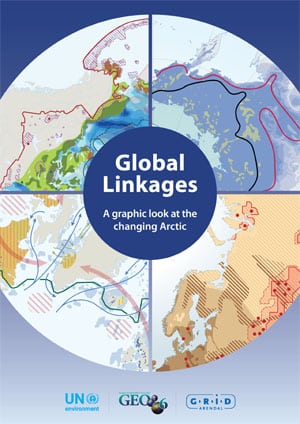
NOTE: The excellent blog Carbon Brief argues that the UN report’s projection is incorrect. See: https://www.carbonbrief.org/factcheck-is-three-five-celsius-of-arctic-warming-now-locked-in
United Nations Environment Assembly
News Release, March 13, 2019
Even if the world were to cut emissions in line with the Paris Agreement, winter temperatures in the Arctic would rise 3-5°C by 2050 and 5-9°C by 2080, devastating the region and unleashing sea level rises worldwide, finds a new report by UN Environment.
Meanwhile, rapidly thawing permafrost could even accelerate climate change further and derail efforts to meet the Paris Agreement’s long-term goal of limiting the rise in global temperature to 2°C, warns Global Linkages – A graphic look at the changing Arctic (pdf).
Other environmental pressures on the Arctic identified by the paper – released at the United Nations Environment Assembly – include ocean acidification and plastic pollution.
“What happens in the Arctic does not stay in the Arctic,” said Joyce Msuya, UN Environment’s Acting Executive Director. “We have the science; now more urgent climate action is needed to steer away from tipping points that could be even worse for our planet than we first thought.”
Even if global emissions were to halt overnight, winter temperatures in the Arctic would still increase 4 to 5°C by 2100 compared to the late 20th century, the study finds. This increase is locked into the climate system by greenhouse gases already emitted and ocean heat storage.
Arctic societies now must respond to climate change through suitable adaptation actions. Arctic Indigenous Peoples already face increased food insecurity. By 2050, four million people, and around 70% of today’s Arctic infrastructure, will be threatened by thawing permafrost, the report notes.
“The urgency to achieve the goals of the Paris Agreement is clearly manifested in the Arctic, because it is one of the most vulnerable and rapidly changing regions in the world,” said the Finnish Minister of the Environment, Energy and Housing, Kimmo Tiilikainen. “We need to make substantial near-term cuts in greenhouse gas emissions, black carbon and other so-called short-lived climate pollutants all over the world.”
The impacts globally would also be huge. From 1979 to the present, Arctic sea ice is estimated to have declined by 40%. Climate models predict that, at the current rate of CO₂emissions, Arctic summers will be ice-free by the 2030s. The melting of the Greenland ice cap and Arctic glaciers contribute to one third of sea level rise worldwide.
Even if the Paris Agreement is met, Arctic permafrost is expected to shrink 45% compared to today. Globally, these frozen soils hold an estimated 1,672 billion metric tonnes of carbon. Increased thawing is expected to contribute significantly to carbon dioxide and methane emissions. The resulting warming will in turn lead to more thawing – an effect known as “positive feedback.” This accelerated climate change could even throw the Paris Agreement’s 2°C goal off track, the report underlines.
Ocean acidification and pollution taking their toll
Ocean acidification is disproportionately impacting Arctic marine species. This is because cold water can hold more dissolved CO2, while melting ice spreads the acidity further. Since the beginning of the industrial revolution, the world’s ocean has become 30% more acidic. The more acidic the water, the more energy Arctic corals, molluscs, sea urchins and plankton must use to build their shells and skeletons.
Despite its pristine image, the Arctic’s geographical characteristics and cold climate mean the region’s ocean, seafloor and coastline are a sink for contaminants from around the globe. Only 1,000 out of the 150,000 chemical substances in use worldwide are regularly monitored. A global approval system for new chemicals is therefore needed, the report argues. Alternative controls are also seen as necessary for chemicals that fall outside of existing treaties.
On a positive note, the amount of regulated chemicals in humans and animals living in the Arctic was found to be decreasing. These include some Persistent Organic Pollutants regulated under UN Environment’s Stockholm Convention. However, the decrease could be due to changing diets.



A single molecule of methane can absorb 21 times more long wave radiation than a molecule of CO2. Methane is released during the anaerobic decomposition of organic matter which is then released into the atmosphere. Significant increases in winter temperatures, as predicted by the science reported in this article, will result in increases in rates of decomposition and a net loss of carbon from this ecosystem. Climate warming of this magnitude will also increase the length of times soils are unfrozen thereby promoting methane release in autumn and winter.
These sustained high temperatures will promote drying of the muskeg and increase wild land fires. Muskeg fires have two impacts on climate change: A muskeg fire releases large quantities of carbon into the atmosphere. Fires in peat are hard to completely extinguish and a fire may smolder for months emitting CO2 all the while; and, following a fire, the loss of insulating moss causes the darker ground to warm faster, thawing the permafrost. A positive feedback loop is initiated.
It’s 175 miles from Cochrane, Ontario, to Moosonee and Moose Factory, Ontario, through muskeg – the world’s largest expanse. The muskeg area extends west through Ontario into the northern stretches of the prairie provinces, a huge area. If indeed temperatures of this magnitude are locked in, then the release of methane and CO2 has been underestimated and it’s possible the earth will see a CH4 + CO2 bombshell that will have unknown dire consequences.